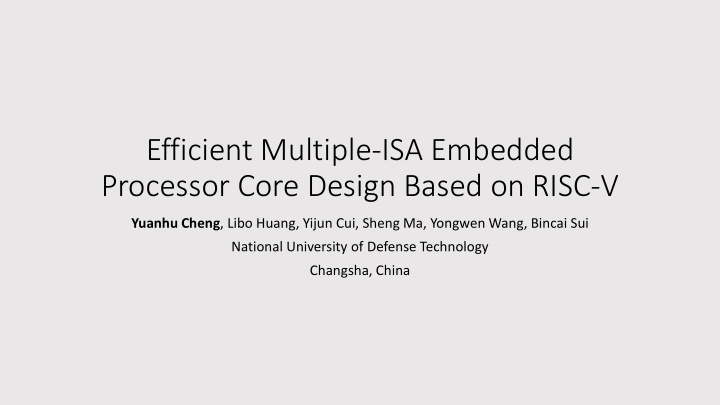



Efficient Multiple-ISA Embedded Processor Core Design Based on RISC-V Yuanhu Cheng , Libo Huang, Yijun Cui, Sheng Ma, Yongwen Wang, Bincai Sui National University of Defense Technology Changsha, China
Cont ntent nts • Introduction • Software compatibility • Solve software compatibility • Support ARM Thumb ISA based on binary translation • Instructions and registers mapping • Some optimizations to improve performance • An Example for ARMv6-M • Benchmarks • Performance and area • Conclusion
Soft ftware compati tibility • A lot of existing software is developed based on a specific ISA • Software compatibility: Software based on one ISA cannot run directly on another ISA processor. • Before the software ecosystem is perfected, the software cost caused by software compatibility will seriously hinder the development of RISC-V • Solve software compatibility ——Run other ISA programs using RISC- V processor
How to solve s software compati tibility • Software methods • Software binary translation system • Hardware methods (multiple-ISA processor) • Hardware binary translation • Multiple decoders for multiple ISAs • Multi-core for multiple ISAs Binary translation Source ISA Target ISA Target ISA instruction instruction processor
Solv Solve sof software c e com ompatib ibil ilit ity for or em embedded • Running environment and performance limit the use of existing software method. • Hardware methods must meet the requirements of the embedded processor: Area and Power. • Simplicity is essential —— we try to use hardware binary translation to achieve a multiple-ISA processor to solve the software compatibility problem that RISC-V faces in the embedded field
Suppo porting ARM Thumb wi with RISC-V • Binary interpreter: Registers and instructions mapping • Some optimizations to improve performance • Optimization 1: Condition flags • Optimization 2: Branch instruction • Optimization 3: Conditional execution
Instruc uction n and register mappi ping • Instruction mapping is to convert the ARM Thumb instruction into the corresponding RISC-V instruction(s). • Register mapping can be achieved by adding a prefix in front of the ARM Thumb register number
Opti timizati tion 1: Conditi tion flags • ARM Thumb condition flags: • Negative flag (N) • Zero flag (Z) • Carry flag (C) • Overflow flag (V) • 7 RISC-V instructions are needed to judge these flags
Opti timizati tion 1: Conditi tion flags • Optimization: supporting condition flags by hardware in RISC-V processor • ALU • Flags register • Control signal
Op Optimization 2: 2: Branch ch ins nstruct ction • Different condition flags implementations lead to different ways to implement branch instructions. • In the worst case, 9 RISC-V instructions are needed to achieve an ARM Thumb branch instruction • Optimization • The role of RS1 field of RISC-V BEQ instruction is modified to represent the condition code (named “ cond") of the ARM Thumb • Hardware logic is added to judge the flags according to the condition code in the execution stage
Opti timizati tion 3: Conditi tional executi tion • ARM Thumb supports conditional execution • There is an IT block after each IT instruction • The instructions in the IT block are conditional execution • An 8-bits register named EPSR.IT is used to support conditional execution • Judging the execution conditions in the execution stage will cause a large number of pipeline cycles to be wasted • Optimization: Putting judgment logic of the execution condition into the binary interpreter
An e example f e for or A ARMv6-M • This example is based on the open-source core of PULPino, called Zero-riscy (Ibex). • ARMv6-M ISA • Microarchitecture
Benchmark rk • Dhrystone and CoreMark • Compiler • ARMCC for ARM Thumb • GNU GCC for RISC-V
Performance • Dhrystone • RISC-V: 0.82 DMIPS/MHz • ARMv6-M: 0.69 DMIPS/MHz • CoreMark • RISC-V: 1.67 CoreMark/MHz • ARMv6-M: 1.22 CoreMark/MHz
FPGA r A resources • LUT consumption increased by 454, 13.5% of Zero-riscy. • FF consumption increased by 37, 1.8% of Zero-riscy
Conclusion • Software ecosystem challenge of RISC-V and the methods for salving software compatibility • Support ARM Thumb ISA based on binary translation • Instructions and registers mapping • Condition flags • Branch instruction • Condition execution • An Example based on Zero-riscy • Dhrystone and CoreMark • 0.69 DMIPS/MHz and 1.22 CoreMark/MHz • FPGA resources increased by less than 13.5%
Thank You! If you have any questions, please let us know!
Recommend
More recommend